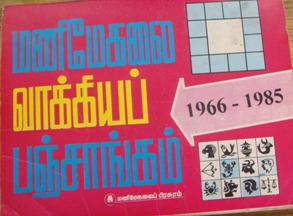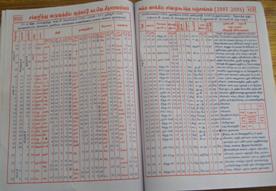Krishi Panchangam
Krishi-Panchang or Agro-almanac or Agro-panchang may be defined as ‘basic astro-agricultural guide book/ calendar published annually, giving calendrical information on various aspects of agriculture and allied activities, basically suggesting region-wise, season-wise and crop-wise crop strategy based on astro meterological predictions, giving auspicious/ inauspicious time for undertaking / avoiding various farm related operations, along with a list of performing religious rites, festival, observation fasts and some non-astrological guidance, primarily useful for the farming communities and person having interest in agricultural development’.
The krishi panchang, being meant for meeting agricultural purposes, majority of its contents should relate to agricultural information. In addition to this, basic information such as annual date calendar, list of holidays, auspicious days/moments of the coming year should be given for the benefit of farming communities.The content of the proposed krishi panchang can broadly be categorized in two major groups as follows
Information which changes every year
- Annual date and Holiday calendar
- Month-wise daily guide for the whole year
- “Rashiphal” , i.e., month-wise forecasting of persons having different zodic signs
- Daily/monthly/annual weather forecasting for the particular year
- Crop propects of that year based on planetary positions
- Season-wise crop strategy based on anticipated weather
Information which remains same irrespective of any particular year
- Theories relating to agricultural and meterological forecasting
- Auspicious moments for agricultural and allied activities
- Some general agricultural guidance
Source: Agricultural Heritage of India By Dr. S.Jeyaraman, Dr. A. Arokiaraj, Dr. M.L.Manoharan
Rashiya Panchangam
The Rashtriya Panchang is being published by the Positional Astronomy Centre since 1879 Saka Era (1957-58 A.D.). This is being done with the objective of unifying the divergent practices of calendar systems existing in different parts of the country and also to promote panchang calculations on a modern scientific basis. The Rashtriya Panchang is being published in the following Indian languages besides Hindi and English.
Assamese, Bengali, Gujarati, Kannada, Malayalam, Marathi, Oriya, Punjabi, Sanskrit, Tamil, Telugu and Urdu.
The timings of sunrise, sunset, moonrise and moonset for 24 stations of India, tithis, nakshatras, yogas and transits of the sun, Moon and planets into Nirayana Rasis and nakshatras, Nirayana longitudes of the Sun, Moon and Planets are calculated accurately with computer and are based on modern scientific principles. The numerical calculations for important items have been explained for the benefit of the users. Calendric tables giving Julian date, Kali Ahargana, Moon’s age and phases have been included for each day of the year and the principal festivals and anniversaries are also given.This publication serves as the standardized Panchang for the country and it is useful as source material for calendric data.
Copies available from
The Controller of Publications, Civil lines, Delhi - 110054
Govt. of India Book Depot, 8, K.S. Roy Road, Kolkata - 700001
Govt. of India Kitab Mahal, Baba Kharak Singh Marg, New Delhi
Govt. of India Book Depot, New Marine Lines, Mumbai
Positional Astronomy Centre, New Alipore, Kolkata - 700053
Other agents selling Govt. of India publications
Tamil panchangam
 |
Tamil Panchangam is a spiritual and scientific Hindu calendar. It is an ancient art of Vedic astrology that helps to maintain the best days and time to come. Tamil Panchangam has been derived from two words Panch(meaning 5) and ang(meaning aspect). The Tamil Panchangam measures time in lunar months whose names reveal the secret path of stars and constellations. It lists four weeks of seven days, identified with planets and gods. This therefore takes into account five aspects - Din(Vara) or the solar day, Tithi or the lunar day, Nakshatra or the constellation,Yoga and Karan. |
It is far more accurate than conventional horoscopes and has loads of empowering practical uses like telling you the best days and times for travel, love, parties, moving, interviews, investments dental visits & lot. To find the auspicious time to start anything new it considers the week day of week (Vara), Tithi, Nakshatra(Star), Yogam of the day, Karana of the day, and the ending moments of all these to determine whether the day is Amurtha, Siddha and Shubha. The Tamil Panchangam is always used as the spiritual expression of time for Hindus and a guide to a life close to God and religion.
Although it is essential to have the knowledge of arithmetical calculations to understand Indian Astrology, but for the benefit of the common people, astrologers have devised a calendar (Panchang) with the help of which, and simple arithmetical calculations, one can have knowledge about planets, good or bad for him.It is not necessary for a common man to be an astrologer in order to understand the Tamil Panchangam. But for a smooth and systematic running of life, one should know how to interpret 'Phalita'.
|

|
Tamil Panchangam means five organs to understand the Phalita. These five things are
Tithi (Date)
Nakshatra (Group of stars)
Yoga (an auspicious moment)
Karan (Half of the part of Tithi)
Vaar (days of the week) |
Tithi: The fifteenth day of the bright half is called Purnima, Paurnima, or Paurnamsasi. It is generally considerd an auspicious day. The fifteenth day of the dark half is called Amavasya. It is called ‘Kuhu’ when the Moon is totally absebt and ‘Sinivali’ when the moon is partially absent. It is generally considered an inauspicious day. The fourth, ninth, and th fourteenth days called ‘Rikta’, i.e., empty days and are not recommended for commencing any new project.
Vara: There are seven days in a week named after the seven principal ‘planets’ (old concept) viz., Sun, Moon, Mars, Mercury, Jupiter, Venus and Saturn and they are believed generally to posses the characteristics of the respective planets
Nakshatra: Nakshatra are constellations of stars. There are twenty seven (or twenty eight) nakshatras enumerated in a fixed order marking the Moon’s heavenly path. Each nakshatra is divided into four padas, or charanas, i.e., quarters. Nine consecutive padas fall in one rashi, i.e., the zodiacal sign.
Rashi: Rashis are the twelve zodiacal signs that mark the imaginary or the apparent path of the sun through space. E.g. Mesha (Aries) and vrishaba (Taurus). The sun takes approximately one month to pass through one sign ( and takes thirteen to fourteen days to pasds through one nakshatra)
In the Hindu method of calculations, although the 365 ¼ days of the revolutions of the earth round the sun are recognised, the calculations are done according to the revolution of the moon round the earth, which falls short by approximately 7 days during one year, when compared to calculations done according to the solar calendar.
The Tamil panchangam, based on the lunar calendar, which also has 12 months in a year comes level with the "Ayanas" or sun calculation by adding a month ( known as Loonth or Purshottam Maas) after every three years.
The time between two consecutive risings of the sun is the day, the Solar day or Din.( according to the Gregorian calendar the day begins at 12.00 P.M.) , according to the Indian calendar the time between two consecutive risings of the moon is taken as LunarDay or Tithi.
The panchang measures time in lunar months whose names reveal the secret path of stars and constellations. The face of the new moon is called Amavasya and it ushers in the new month. The first fortnight of the full moon is known as Shuklapaksha "the bright half" as the moon waxes; while the dark half fortnight of the month is called Krishnapaksha during which the moon wanes.
Vyavasaya Panchagam – A Farmers Almanac
Vyavasaya Panchangam – a farmers almanac is prepared and published by Acharya N.G. Ranga Agricultural University in Telugu and is released every year by the Hon’ble Chief Minister of Andhra Pradesh on the eve of Ugadi Telugu new year’s day celebrations at Ravindra Bharathi for the benefit of the farming community.
Vyavasaya Panchangam - a farmers crops, dry land agriculture, water man soil, water and plant material sampling procedure, use of plastics in agriculture, Modern Agril. Implements, WTO in Agriculture, Biological control of pests, sericulture, Bee keeping, Vermi compost, soil reclamation, Termites and their control, climatic based Agro advisory system, compatibility among the pesticides, fungicides and fertilisers, besides other allied activities like dairy, Poultry, Goat and Sheep rearing, Rabbit, fish and prawn culture, fodder crops and Home Science aspects like foods and Nutrition, Child education, low cost energy saving methods, Natural dyes, strain agement in different crops, micro irrigation, removal on cloths.
The Panchangam is revised every year in tune with the latest developments in Agriculture and allied aspects.The main focus of the Vyavasaya Panchangam is to give holistic scientific knowledge on farming and other allied technologies |
|
http://www.angrau.net/vpan2005.htm
|

